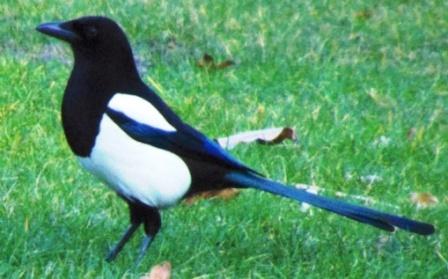The Magpie (Pica pica) is up to 50 cm, 25-30 cm long tail included. They weigh 200-300 grams, have a wingspan of 52 to 60 cm and is very recognizable black and white (: belly and shoulder). Legs and beak are black. Magpies have a long, diamond-shaped, stepped tail that goes up immediately on landing. On the ground, he don’t walk but hops.
 Magpies form lifelong pairs. Their nest is large and covered from top to protect against predators. It is reinforced with earth and clay and lined with thin roots. The entrance is hidden on the side where the wind is least. They lay 5-6 small, blue-green eggs with brown gray spots.
Magpies form lifelong pairs. Their nest is large and covered from top to protect against predators. It is reinforced with earth and clay and lined with thin roots. The entrance is hidden on the side where the wind is least. They lay 5-6 small, blue-green eggs with brown gray spots.
The magpie is the only non- mammal that can recognize itself in a mirror. (With reflective windows sometimes he picks the setting loose.)
It is a brutal, watchful but not shy bird that lives close to humans.
Insects constitute 70 to 90% of the menu. He picks up the ticks of cows, deer and sheep. In addition, the omnivore lust worms, fruit, food scraps, corn, eggs and young birds.
Prey remains: eggs picked open and eaten from the side.
Magpies hiding prey sometimes under humus and leaf.
Pellets measure 10-20 mm x 35 mm and are oval, cylindrical.
Protect little chicks by keeping them shielded in a run.
They got a bad name compared with other corvids because they are mostly just active during the day and therefore visible (and easily recognizable).
Despite their name as a thief there would never encountered a shiny object in their nest at all checks implemented so far!
It seems that magpies (like other birds) are rather afraid of shiny objects. (British research, Animal Cognition 'The thieving magpie? "No evidence for attraction to shiny objects (August 2014))
